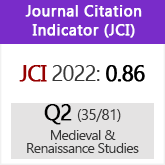Sebestén y zumaque, dos frutos importados de Oriente durante la Edad Media
DOI:
https://doi.org/10.3989/aem.2001.v31.i2.271Keywords:
sebesten, sumac, Syria, Andalusian authors, medieval trade, history of botany, Middle AgesAbstract
This paper joins a number of historical pieces of information concerning two species of Asiatic origin, sebesten and sumac, whose fruits are mentioned among the goods brought to Barcelona from Syria during the fourteenth and fifteenth centuries. In the case of the sebesten, we are in front of a tree native to India (Cordia myxa L.), whose edible fruits were employed to make a birdlime employed to catch birds. As for the sumach (Rhus coriaria L.), the fruits of this shrub were used traditionally to tan the leather. The information here offered has been taken from Grecolatin, Andalusian and later authors.
Downloads
Download data is not yet available.
Downloads
Published
2001-12-30
How to Cite
García Sánchez, E., & Ramón-Laca Menéndez de Luarca, L. (2001). Sebestén y zumaque, dos frutos importados de Oriente durante la Edad Media. Anuario De Estudios Medievales, 31(2), 867–881. https://doi.org/10.3989/aem.2001.v31.i2.271
Issue
Section
Monographies
License
Copyright (c) 2001 Consejo Superior de Investigaciones Científicas (CSIC)

This work is licensed under a Creative Commons Attribution 4.0 International License.
© CSIC. Manuscripts published in both the printed and online versions of this Journal are the property of Consejo Superior de Investigaciones Científicas, and quoting this source is a requirement for any partial or full reproduction.All contents of this electronic edition, except where otherwise noted, are distributed under a “Creative Commons Attribution 4.0 International” (CC BY 4.0) License. You may read here the basic information and the legal text of the license. The indication of the CC BY 4.0 License must be expressly stated in this way when necessary.
Self-archiving in repositories, personal webpages or similar, of any version other than the published by the Editor, is not allowed.














